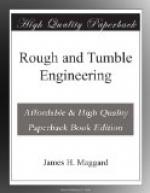Now, as far as doing the work is concerned, it is not absolutely necessary that you know this; but if you do know it, you are more likely to profit by it and thereby get the best results out of your engine. And as this is our object, we want you to know it, and be benefitted by the knowledge. Suppose you are on the road with your engine and load, and you have a stretch of nice road. You are carrying a good head of steam and running with lever back in the corner or lower notch. Now your engine will travel along its regular speed, and say you run a mile this way and fire twice in making it. You now ought to be able to turn around and go back on the same road with one fire by simply hooking the lever up as short as it will allow to do the work. Your engine will make the same time with half the fuel and water, simply because you utilize the expansive force of the steam instead of using the live steam from boiler. A great many good engines are condemned and said to use too much fuel, and all because the engineer takes no pains to utilize the steam to the best advantage.
I have already advised you to carry a “high pressure;” by a high pressure I mean any where from I00 to I25 lbs. I have done this expecting you to use the steam expansively whenever possible, and the expansive force of steam increases very rapidly after you have reached 70 lbs. Steam at 80 lbs. used expansively will do nine times the work of steam at 25 lbs. Note the difference. Pressure 3 I-5 times greater. Work performed, 9 times greater. I give you these facts trusting that you will take advantage of them, and if your engine at I00 or I00 lbs. will do your work cutting off at I/4, don’t allow it to cut off at I/2. If cutting off at I/2 will do the work, don’t allow it to cut off at 3/4, and the result will be that you will do the work with the least possible amount of fuel, and no one will have any reason to find fault with you or your engine.
Now we have given you the three points which are absolutely necessary to the successful handling of a traction engine, We went through it with you when running as a stationary; then we gave you the pointers-to be observed when running as a traction or road engine. We have also given you hints on economy, and if you do not already know too much to follow our advice, you can go into the field with an engine and have no fears as to the results.
How about bad bridges?
Well, a bad bridge is a bad thing, and you cannot be too careful. When you have questionable bridges to cross over, you should provide yourself with good hard-wood planks. If you can have them sawed to order have them 3 inches in the center and tapering to 2 inches at the ends. You should have two of these about 16 feet long, and two 2x12 planks about 8 feet long. The short ones for culverts, and for helping with the longer ones in crossing longer bridges.




